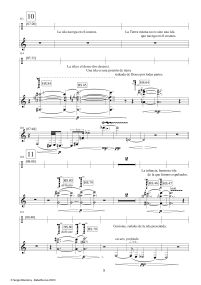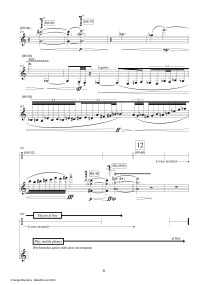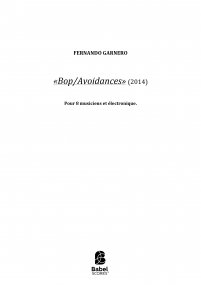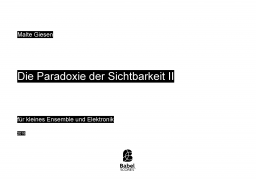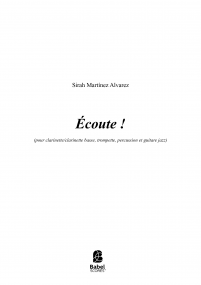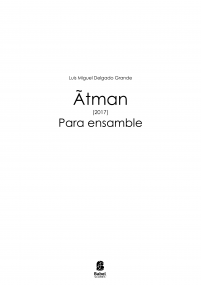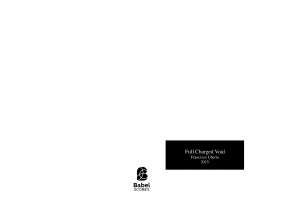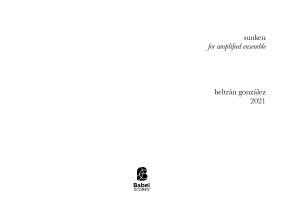Recherche avancée
Islas: solo es real la niebla
For bass clarinet, electronics and small portable devices (mobile telephones or small speakers).
About texts by Andrés Sánchez Robayna.
About texts by Andrés Sánchez Robayna.
17,00 €
Version numérique (+0,00 €) à télécharger
Version papier (+14,80 € impression et livraison ). Colissimo7-14 days aprox.
Chez BabelScores, quand vous achetez une partition, vous pouvez ensuite contacter directement le compositeur ici même !
Caractéristiques
Region
Europe
Estimated Duration
11 - 15min
Date
2022
ISMN : 979-0-2325-6696-2
Vidéos
Notes sur cette pièce COMENTARIO
Islas: solo es real la niebla nace como expresión de una imposibilidad: la distancia como un hecho objetivo que, cuando es sometida a la experiencia de lo temporal, se vuelve imposible de determinar. Quiero decir que, muchas veces, recorremos un trayecto y, después, éste mismo nos parece muy diferente. Más largo o corto pero distinto. Esta relación con el espacio –y con el tiempo que va indisolublemente unido a él- lleva a aproximarse, en la obra artística, desde una perspectiva nada unívoca. Y esto es lo que me conduce a la idea de trabajar con el concepto “isla” o “islas”. El aislamiento de un lugar, rodeado de un agente en principio hostil (como es el océano), genera diferentes estados e interpretaciones: la isla vista desde lejos pero también desde ella, con los pies en ella.
Como escribe Andrés Sánchez Robayna –cuyos textos de su libro Cuaderno de las islas (Lumen, 2011) han sugerido gran parte de mi composición, y se escuchan en la electrónica de la pieza- “La isla navega en el cosmos. La Tierra misma no es sino una isla que navega en el cosmos.” Por tanto, no nos encontramos ante algo estático, una porción de tierra en el mar, sino que –bajo esa misma idea de que nada está realmente quieto, ni lo más estático por mucho que esté pegado a la Tierra- hay un presente que se mueve continuamente y va generando una perspectiva de la que no podemos evadirnos.
Mi música, en este caso, atiende a ese movimiento, un movimiento que no es de un trazo reconocible ni formalmente determinado, al menos así lo entiendo yo. Pueden encontrarse motivos o estructuras parecidas a lo largo de la obra, pero éstas, están en constante cambio –aunque sea mínimo, quizá una modificación sutil-, algo que, como he dicho, afecta a ese transitar por lo ya conocido pero –indefectiblemente- transitado de otro modo cuando se vuelve a pasar sobre ello. Cuando el tiempo nos hace que transitemos de nuevo sobre ello. Y esto conforma, en definitiva, una nueva mirada. Así se traza esta música: caminando sobre un mismo trayecto lleno de islas, que son una misma isla pero, realmente, son otras islas.
La obra también está escrita como homenaje a dos grandes personalidades de la música de nuestro tiempo: por un lado, a Harry Sparnaay –clarinetista bajo prematuramente desaparecido, y con el que me unía una amistad- y, por otro, a mi maestro de composición: José Luis de Delás, cuya obra Einlanden (para ensemble y electrónica) alude a las islas que, mediante canales, conforman la ciudad de Amsterdam, por cierto, ciudad de nacimiento de Harry.
Por otro lado, la obra está dedicada a la clarinetista Lara Díaz, a la que agradezco sus comentarios y el trabajo realizado con ella.
COMMENT
Islas: solo es real la niebla (Islands: the only thing that’s real is the fog) that is born with expression of an impossibility. The distance is a metaphor for when you are subjected to something temporary (temporal mean temporary or seasons) and it turns impossible to determine. I want to say that a lot of the time, we constantly take the same path and after, it can seem very different. The destiny can be long or short. The space in this relationship and time make it unbreakable by being united with the music. From a perspective it is nothing ambiguous-and this is what connected my idea to work with islas (islands). The isolation of a place surrounded by people. This generates different states of interpretation: The island is seen from far away but you can see it from up close.
Roboyana writes- whose text from the book Cuadernos de la isla (book of the islands) is a huge inspiration for my composition and you can hear it through the electronics of the piece- “The island navigates through cosmos. The land itself is not but an island that navigates in the cosmos. “Therefore we don’t find ourselves with something ecstatic, a portion of the land in the sea, but also- under that same idea that nothing is calm, not even the most ecstatic that is attached to the earth, there are who move continuously and generate a perspective that we cannot involve ourselves.
In this case, my music serves to that movement, the movement that has recognizable trace or determined formally, at least that’s how I understood it. You can find the motive and structure being similar throughout the work, but they are constantly changing- Even though it is minimal, maybe it is a subtle modification-, as the saying goes, it affects the path for the known but- without fail- when you pass the island, again, you will find another path. When time makes us take another path, it makes sense to go through again. And this conforms, definitely a new site. This is how the music is traced: walking the same path filled (or surrounded) with islands, which are the same islands but, in reality, they are other islands.
The work is also an homage for the two biggest personalities from the music of our time: One is Harry Sparnaay- a bass clarinetist and a good friend of mine, who passed too early. Another is my composition teacher: José Luis de Delás, whose work Einladen (for ensemble and electronics) alludes to the islands through the canals of the city of Amsterdam, the city where Harry was born.
This work is dedicated to clarinetist, Lara Díaz, I have appreciated her commentary and the work I have done with her.
Ajouter à une playlist
- Identifiez-vous pour créer une liste
Islas: solo es real la niebla nace como expresión de una imposibilidad: la distancia como un hecho objetivo que, cuando es sometida a la experiencia de lo temporal, se vuelve imposible de determinar. Quiero decir que, muchas veces, recorremos un trayecto y, después, éste mismo nos parece muy diferente. Más largo o corto pero distinto. Esta relación con el espacio –y con el tiempo que va indisolublemente unido a él- lleva a aproximarse, en la obra artística, desde una perspectiva nada unívoca. Y esto es lo que me conduce a la idea de trabajar con el concepto “isla” o “islas”. El aislamiento de un lugar, rodeado de un agente en principio hostil (como es el océano), genera diferentes estados e interpretaciones: la isla vista desde lejos pero también desde ella, con los pies en ella.
Como escribe Andrés Sánchez Robayna –cuyos textos de su libro Cuaderno de las islas (Lumen, 2011) han sugerido gran parte de mi composición, y se escuchan en la electrónica de la pieza- “La isla navega en el cosmos. La Tierra misma no es sino una isla que navega en el cosmos.” Por tanto, no nos encontramos ante algo estático, una porción de tierra en el mar, sino que –bajo esa misma idea de que nada está realmente quieto, ni lo más estático por mucho que esté pegado a la Tierra- hay un presente que se mueve continuamente y va generando una perspectiva de la que no podemos evadirnos.
Mi música, en este caso, atiende a ese movimiento, un movimiento que no es de un trazo reconocible ni formalmente determinado, al menos así lo entiendo yo. Pueden encontrarse motivos o estructuras parecidas a lo largo de la obra, pero éstas, están en constante cambio –aunque sea mínimo, quizá una modificación sutil-, algo que, como he dicho, afecta a ese transitar por lo ya conocido pero –indefectiblemente- transitado de otro modo cuando se vuelve a pasar sobre ello. Cuando el tiempo nos hace que transitemos de nuevo sobre ello. Y esto conforma, en definitiva, una nueva mirada. Así se traza esta música: caminando sobre un mismo trayecto lleno de islas, que son una misma isla pero, realmente, son otras islas.
La obra también está escrita como homenaje a dos grandes personalidades de la música de nuestro tiempo: por un lado, a Harry Sparnaay –clarinetista bajo prematuramente desaparecido, y con el que me unía una amistad- y, por otro, a mi maestro de composición: José Luis de Delás, cuya obra Einlanden (para ensemble y electrónica) alude a las islas que, mediante canales, conforman la ciudad de Amsterdam, por cierto, ciudad de nacimiento de Harry.
Por otro lado, la obra está dedicada a la clarinetista Lara Díaz, a la que agradezco sus comentarios y el trabajo realizado con ella.
COMMENT
Islas: solo es real la niebla (Islands: the only thing that’s real is the fog) that is born with expression of an impossibility. The distance is a metaphor for when you are subjected to something temporary (temporal mean temporary or seasons) and it turns impossible to determine. I want to say that a lot of the time, we constantly take the same path and after, it can seem very different. The destiny can be long or short. The space in this relationship and time make it unbreakable by being united with the music. From a perspective it is nothing ambiguous-and this is what connected my idea to work with islas (islands). The isolation of a place surrounded by people. This generates different states of interpretation: The island is seen from far away but you can see it from up close.
Roboyana writes- whose text from the book Cuadernos de la isla (book of the islands) is a huge inspiration for my composition and you can hear it through the electronics of the piece- “The island navigates through cosmos. The land itself is not but an island that navigates in the cosmos. “Therefore we don’t find ourselves with something ecstatic, a portion of the land in the sea, but also- under that same idea that nothing is calm, not even the most ecstatic that is attached to the earth, there are who move continuously and generate a perspective that we cannot involve ourselves.
In this case, my music serves to that movement, the movement that has recognizable trace or determined formally, at least that’s how I understood it. You can find the motive and structure being similar throughout the work, but they are constantly changing- Even though it is minimal, maybe it is a subtle modification-, as the saying goes, it affects the path for the known but- without fail- when you pass the island, again, you will find another path. When time makes us take another path, it makes sense to go through again. And this conforms, definitely a new site. This is how the music is traced: walking the same path filled (or surrounded) with islands, which are the same islands but, in reality, they are other islands.
The work is also an homage for the two biggest personalities from the music of our time: One is Harry Sparnaay- a bass clarinetist and a good friend of mine, who passed too early. Another is my composition teacher: José Luis de Delás, whose work Einladen (for ensemble and electronics) alludes to the islands through the canals of the city of Amsterdam, the city where Harry was born.
This work is dedicated to clarinetist, Lara Díaz, I have appreciated her commentary and the work I have done with her.
Instrumentation
Bass clarinet
Score Details
Format - A4 / US Letter
Pages - 14
Pages - 14



